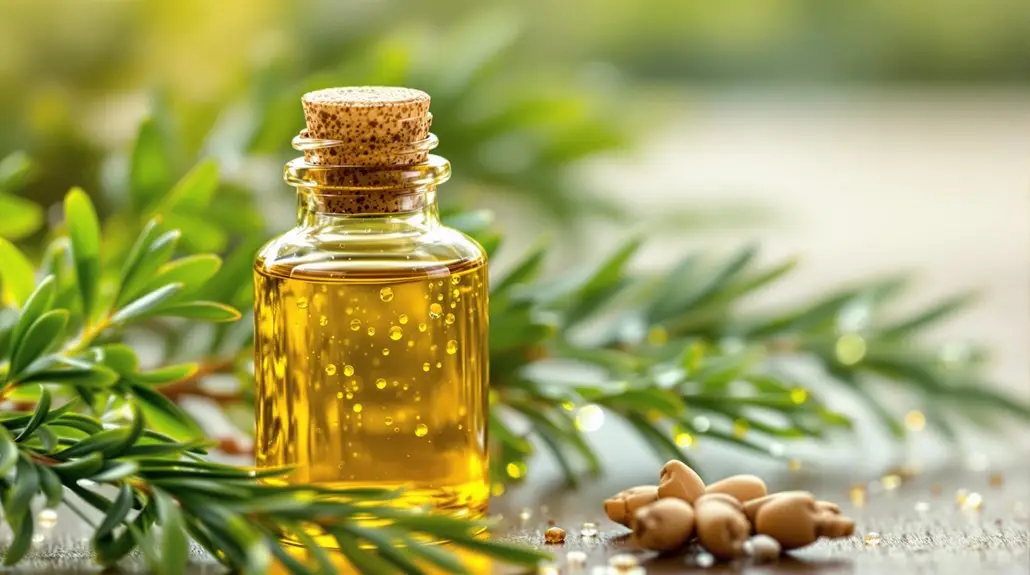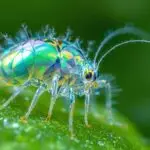Cedar oil’s composition, rich in compounds like α-cedrene, β-cedrene, and cedrol, makes it an effective natural pesticide. It works by dehydrating insects, disrupting their pheromones, and harming their nervous systems, which can lead to suffocation and paralysis. This oil effectively targets pests like ants, mosquitoes, and cockroaches while being secure for the environment and humans, classified as Generally Recognized as Safe (GRAS) by the FDA. You can apply it through various methods, ensuring efficient pest control. If you’re curious about its application techniques and broader benefits, there’s plenty more to explore.
Key Insights
- Cedar oil is primarily composed of α-cedrene (15-25%), β-cedrene (25-35%), and cedrol (minimum 20%), contributing to its pesticidal properties.
- The oil dehydrates insects, disrupts pheromone signals, and affects neurological functions, leading to suffocation and paralysis in pests.
- Cedar oil is effective against a variety of pests, including ants, ticks, moths, and mosquitoes, achieving 100% mortality in ticks at 6.3 mg/ml dosage.
- Application methods such as spray techniques allow for targeted control, with adjustments in concentration based on specific pest types.
- Classified as Generally Recognized as Safe (GRAS), cedar oil presents minimal risk compared to synthetic pesticides, promoting its use as a natural pest control solution.
Cedar Oil Composition
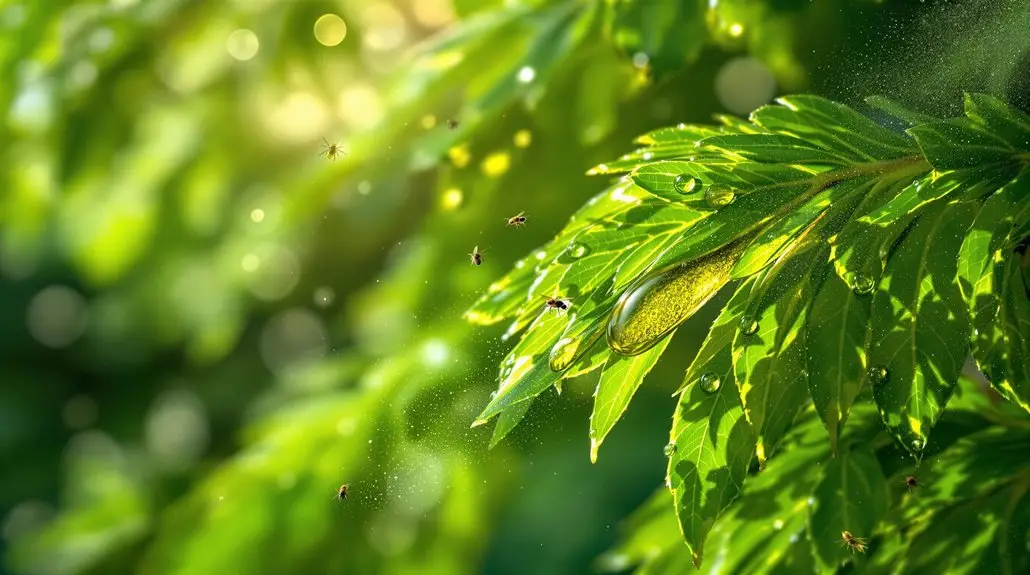
Cedar oil, primarily known as cedarwood oil, boasts a unique composition that makes it valuable in various applications. Extracted from the dry roots or chopped wood of the Texas cedar, it contains key components like α-cedrene, β-cedrene, and cedrol. These compounds give cedar oil its distinctive properties, making it not just a pleasant aroma but also a potential solution for pest control and other uses. Additionally, cedar oil is recognized for its effectiveness against various life stages of insects, including eggs and larvae, through dehydration and contact. Moreover, it is important to note that many pest control services, such as NaturePest’s eco-friendly solutions, incorporate natural ingredients like cedar oil for safer pest management.
When you explore cedar oil, you’ll notice that α-cedrene comprises about 15-25% of the oil, while thujopsene makes up an impressive 25-35%. Cedrol, another important component, has a minimum concentration of 20%. This combination creates a viscous liquid that can range from brown to reddish-brown. You’ll find that it may even partially solidify at room temperature, which adds to its unique character. Additionally, the extraction process primarily involves steam distillation; this method is commonly used to obtain cedarwood oil and yields about 1-6% of oil from crude sources, but advancements like CO2 supercritical fluid extraction can increase both the quantity and quality of cedrol considerably.
Security is a priority, as cedar oil is non-toxic to humans but can irritate skin and eyes. So, it’s important to handle it carefully and store it in a ventilated, dry place.
Understanding cedar oil’s composition not only helps you appreciate its benefits but also connects you to a world of natural solutions that many others are discovering.
Mechanisms of Action
Utilizing its unique properties, cedar oil acts on pests through several mechanisms that contribute to its effectiveness as a natural insecticide. One of the primary ways it works is by dehydrating insects. When pests come into contact with cedar oil, it leaches moisture from their bodies, drying out both adult and juvenile insects, as well as their eggs and larvae. This dehydration disrupts their exoskeletons, impairing essential bodily functions and leading to their demise. Additionally, the rapid moisture loss that occurs upon contact further accelerates the insects’ decline. Furthermore, cedar oil is known for its insect-repelling characteristics, making it a valuable tool in integrated pest management strategies.
Cedar oil also disrupts the pheromones that insects rely on for navigation and mating. By interfering with these chemical signals, it confuses bugs, impairing their ability to find food or mates. This disorientation not only makes them relocate but also disrupts their egg-laying cycles, further diminishing their populations.
Moreover, cedar oil dissolves the exoskeleton of insects, allowing it to penetrate and enhance its pest control effects. This erosion leads to dehydration and ultimately death, as the oil exposes their internal systems.
Lastly, cedar oil impacts the neurological functions of insects. It disrupts their breathing mechanisms, causing suffocation and paralysis. By neutralizing the internal acidity within their bodies, cedar oil throws off their essential chemical balance, leading to systemic failure.
Efficacy Against Pests
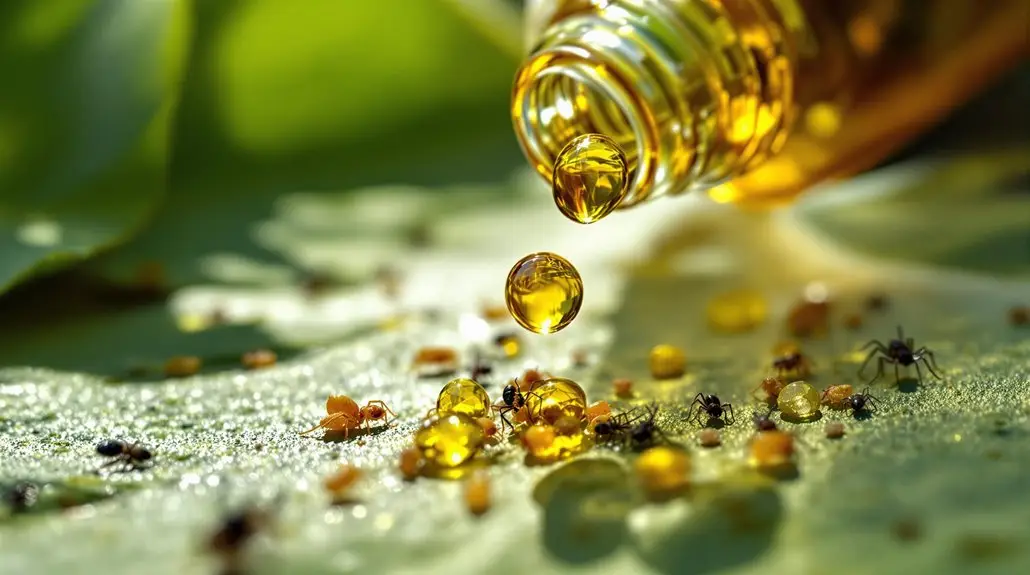
The effectiveness of cedar oil as a natural insecticide is evident across various pest types and scenarios. If you’re seeking a reliable solution to pest problems, you’ll find cedar oil to be particularly effective against common annoyances like ants, ticks, moths, mosquitoes, and silverfish.
For instance, in outdoor settings, cedarwood oil keeps ants at bay, ensuring they can’t reach food sources. When it comes to ticks, studies show that a dosage of 6.3 mg/ml leads to 100% mortality, making it a formidable defense. Cedarwood oil has also been shown to significantly repel ants from food sources due to its effective barrier. Additionally, integrated pest management (IPM) strategies often incorporate natural solutions like cedar oil for a more sustainable approach.
Indoors, cedar oil shines against household invaders like termites, spiders, beetles, and cockroaches, thanks to its natural repelling properties. You’ll appreciate how it disrupts pest life cycles; it dissolves insect eggs, triggers dehydration in larvae, and even confuses adult insects by blocking essential receptors. Additionally, the terpenes in cedarwood oil are specifically known to confuse pests, impairing their ability to find food or reproduce.
This means fewer pests and a healthier living environment for you and your loved ones.
What’s even better is that cedar oil is a non-toxic alternative to chemical pesticides, secure for beneficial insects like bees. You won’t have to worry about resistance build-up, making it a long-term solution that’s both cost-effective and easy to reapply. Studies show that eco-friendly products significantly reduce chemical exposure in homes, enhancing safety.
If you’re tired of battling annoying invaders, cedar oil not only offers quick re-entry times but also a broad spectrum of efficacy against various life stages of pests. Embrace cedar oil as your go-to pest control ally!
Application Methods
Spray Application Techniques
Effective spray application techniques are essential for guaranteeing that cedar oil reaches its target and maximizes pest control. You’ll want to take into account using hydraulic sprayers, which create pressure to effectively deliver the spray to your plants. For greenhouse applications, low-volume sprayers are perfect, as they cater to specific crops and growing methods. Pay attention to the nozzle variations; they help break the spray into smaller droplets for more precise application. When applying cedar oil, techniques like foliar spray guarantee the product directly contacts the plant foliage, increasing effectiveness. Area saturation is another method, where you thoroughly spray areas where pests are prevalent, such as flower beds or standing water. Additionally, the recommended mixture for general pests is 97% water, 1.3% cedar oil to ensure optimal effectiveness. Remember to reapply monthly if pests persist. Using hose and sprayer systems can streamline your application process, making it quicker and more efficient. Always aim for uniform distribution to avoid underdosing or overdosing, which can waste resources or contaminate groundwater. Moreover, calibration and operation of your sprayer is crucial to ensure accurate application rates and effective pest management. Keep security in mind by adhering to EPA standards, guaranteeing your mixture is suitable for pets and humans, and testing the solution on a small area first. Following these guidelines will help you achieve successful pest control with cedar oil.
Direct Application Strategies
Direct application strategies for cedar oil offer a targeted approach to pest control, ensuring that the solution effectively reaches the pests where they congregate. By using a spray applicator, you can directly apply cedar oil to areas like flower beds, shrubs, and even standing water.
For general pest control, a mixture of 97% water and 1.3% cedar oil works well, but feel free to adjust the concentration based on the pest type. For instance, termites may require a stronger mix. Cedar oil is a contact killer that dehydrates and eliminates insect larvae and eggs, making it particularly effective against pests.
When dealing with ticks and mosquitoes, applying cedar oil to their habitats can dehydrate and disrupt their behavior. If you’re into beekeeping, a well-aimed spray on entrance boards and hive stands can help manage pests like small hive beetles. Additionally, the 10% cedar oil concentration in Dr. Bens Evictor is particularly effective against a range of pests, enhancing your pest control efforts.
Remember, reapplication might be necessary, especially in areas with high pest activity. Always test your solution on a small area first to avoid any unwanted reactions.
Cedar oil is generally harmless for you, your pets, and beneficial insects, making it a great choice for those who care about the environment. By following these direct application strategies, you’re joining a community that values effective and eco-friendly pest control solutions.
Ground Treatment Methods
Ground treatment methods utilizing cedar oil provide versatile options for managing pest populations effectively. You can choose from several application techniques to suit your needs. Here’s a quick overview:
| Method | Description | Frequency & Security |
|---|---|---|
| Soil Drenching | Mix cedar oil with water and saturate soil to target underground pests. | Repeat every few days; secure for pets. |
| Lawn Spraying | Spray cedar oil solution on the lawn surface to combat pests like ticks. | Best after mowing; fast-acting. |
| Soil Injection | Inject cedar oil directly into the soil for targeted pest control. | Adjust concentration as needed; avoid over-saturation. |
| Broadcast Application | Spread a diluted solution over large areas to prevent infestations. | Regular applications for best results; minimizes harm to beneficials. |
These methods not only help manage pests but also contribute to soil health and biodiversity through the careful application of natural materials. Additionally, the use of cedar oil is particularly beneficial as it is considered Generally Recognized as Safe (GRAS) by the EPA, ensuring a safer approach to pest control.
Safety and Environmental Impact
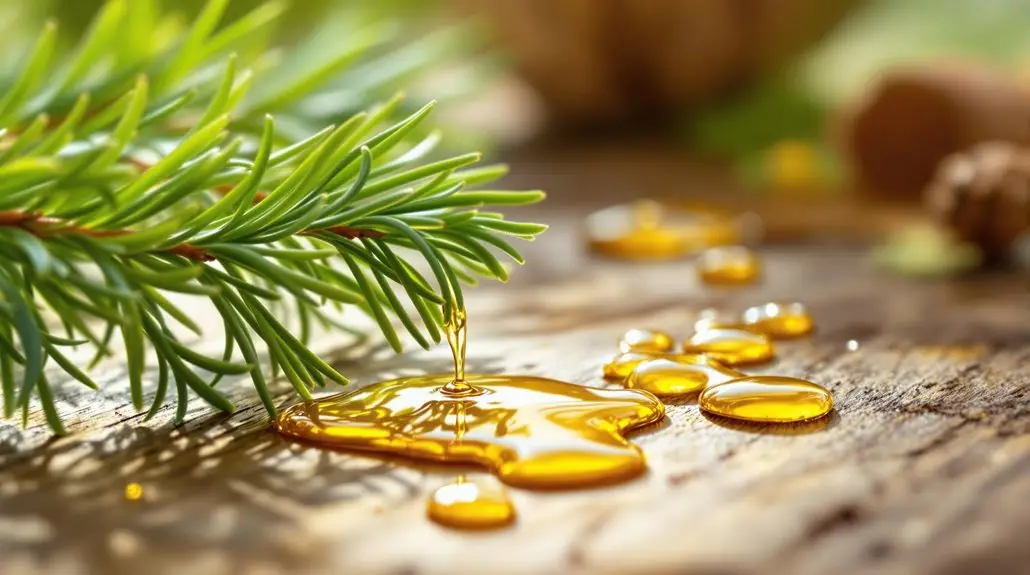
How does cedarwood oil stack up regarding security and environmental impact? You’ll be pleased to know that cedarwood oil is considered Generally Recognized as Safe (GRAS) by the FDA, which means it’s a trusted option for use.
The EPA doesn’t expect toxic effects from currently registered cedarwood oil products due to the low-level exposure they typically present. When used properly, the risk to both humans and the environment is negligible. Furthermore, products containing cedarwood oil are often made with minimum risk pesticides that prioritize safety. Additionally, the presence of cedrol in cedar species contributes to its pesticidal properties, further enhancing its effectiveness as a natural pest control agent.
While laboratory studies suggest some potential for liver and pulmonary toxicity with long-term exposure to high levels, this isn’t a concern with typical use. It’s vital, however, to handle these products correctly to avoid any adverse effects, such as respiratory or dermal irritation. Fortunately, no significant sensitization issues have been reported.
On the environmental front, assessments show that careful management is essential. Cedarwood oil can emit into the air and water, potentially affecting soil if wastewater isn’t treated properly. The risk of bioconcentration in organisms is also considered, ensuring we stay mindful of how we use and dispose of these products.
Compared to synthetic pesticides, cedarwood oil stands out as a more secure alternative. It doesn’t carry the same long-term health risks, nor does it contribute to resistance development in pests.
Regulatory Information
When you’re considering using cedarwood oil as a pesticide, you’ll want to know its EPA registration status. Cedarwood oil is recognized as a minimum risk pesticide, which means it’s exempt from many regulations but still has to meet specific EPA guidelines. Pesticides require registration to ensure their safety and effectiveness before they can be marketed. You can find various commercial products available that comply with these standards, ensuring secure use in your applications.
EPA Registration Status
Cedarwood oil stands out as a unique option in the world of pesticides, thanks to its status as a minimum risk pesticide exempt from the Federal Insecticide, Fungicide, and Rodenticide Act regulations. This makes it an attractive choice for those who prioritize security and sustainability in their pest control methods.
Here are three key points about cedarwood oil‘s EPA registration status:
- Generally Recognized as Safe (GRAS): The EPA considers cedarwood oil secure and even allows its use as a food additive.
- Minimal Data Requirements: Most generic data requirements have been waived by the EPA, but specific product details are still needed for reregistration.
- Low Risk: Cedarwood oil’s use in registered pesticide products won’t pose unreasonable risks to human health or the environment when used according to approved labeling. Additionally, it is classified as a minimum risk pesticide, emphasizing its safety for use around pets and children.
Commercial Product Availability
The commercial availability of cedar oil products is growing rapidly, offering consumers a variety of options for pest control. You can find cedar oil in several formats, including solid blocks, concentrates, and ready-to-use sprays. These products effectively repel moths, fleas, and other insects, while also helping to prevent mildew growth. As the global cedarwood oil market is expected to reach USD 639.78 million by 2032, this indicates a rising consumer interest in natural solutions for pest management.
If you’re looking for outdoor solutions, specialized products are available for lawns and kennels, ensuring you can protect your pets and environment. DG Cedar Oil products are among the competitive offerings in the market, catering to various pest control needs.
Most cedar oil products are marketed as organic and minimum risk pesticides, making them a great choice for eco-conscious consumers. Prices vary widely; you might spend anywhere from $12.95 for a small applicator to $209.95 for a gallon of concentrate.
The EPA regulates these products, requiring specific labeling and toxicity testing, but cedar oil enjoys an exemption from federal registration, simplifying the buying process for you.
Whether you need indoor or outdoor solutions, cedar oil products are designed to meet your needs. With the global market for cedarwood oil growing, you’re part of a community that values health and sustainability in pest control.
Frequently Asked Questions
How Long Does Cedar Oil Remain Effective After Application?
Cedar oil typically remains effective for about one to three years after application, depending on various factors.
To keep it working its magic, you’ll want to reapply regularly, especially after environmental changes.
Remember, humidity and air exposure can affect its potency, so storing it properly can help extend its lifespan.
Can Cedar Oil Be Mixed With Other Natural Pesticides?
Yes, you can mix cedar oil with other natural pesticides!
Combining it with oils like lemongrass and peppermint enhances its effectiveness against pests. Just make sure you dilute it properly according to the manufacturer’s instructions.
This not only boosts pest control but also keeps your garden secure for beneficial insects.
Embracing these natural solutions allows you to create a healthier environment while protecting your space, making you feel more connected to nature and your community.
What Pests Are Resistant to Cedar Oil?
You’ll find that some pests show resistance to cedar oil. German cockroaches often don’t respond, indicating a level of resistance.
Forage mites and peanut trash bugs can vary in their susceptibility too.
Two-spotted spider mites seem to prefer sandalwood oil, suggesting cedar oil mightn’t be as effective for them.
It’s essential to remember that the effectiveness can depend on the specific pest and conditions you’re dealing with.
Is Cedar Oil Safe for Edible Plants?
When it comes to gardening, you want to keep your plants protected, and cedar oil‘s got your back.
It’s recognized as secure for edible plants, so you can use it without worry. Since it’s a natural solution, you won’t have to deal with harmful residues or toxic chemicals.
Plus, it protects beneficial insects while effectively keeping pests at bay.
How Should Cedar Oil Be Stored for Maximum Potency?
To store cedar oil for maximum potency, keep it cool, ideally below 50°F (10°C), and maintain humidity levels between 75% and 85%.
Use airtight containers to reduce air exposure, and place them in shaded areas to avoid sunlight.
Limit how often you open the containers to preserve freshness, and consider adding ethanol for extended shelf life.
Regularly check your oil for any signs of degradation to guarantee it stays effective for your needs.
Conclusion
In the dance of nature, cedar oil emerges as a powerful partner, weaving its pesticidal magic against pests while nurturing the environment. Its unique composition and effective mechanisms of action make it a formidable ally in pest management. As you explore application methods, remember that security and environmental impact are paramount.
At NaturePest Holistic Pest Control, we invite you to embrace cedar oil not just as a solution, but as a harmonious choice that protects your garden and respects the delicate balance of life around us. Join us in the movement towards eco-friendly pest management and discover the benefits of cedar oil in your own garden today!

